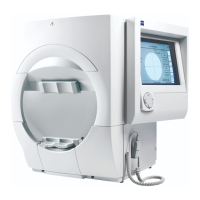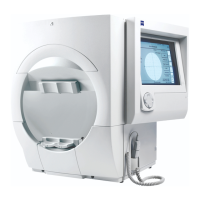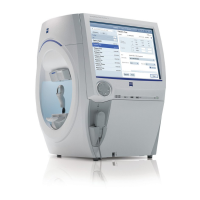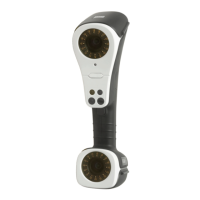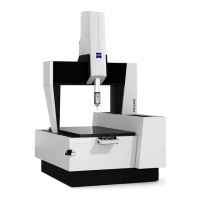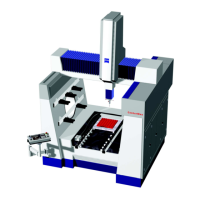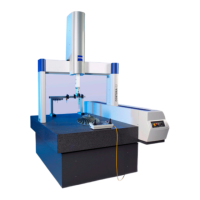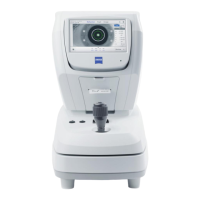Do you have a question about the Zeiss HUMPHREY 740i and is the answer not in the manual?
Highlights the benefits of computerized perimetry and the unique features of the Humphrey Field Analyzer II for patients and professionals.
Describes SITA testing strategies for achieving precise visual field measurements with unprecedented speed.
Explains STATPAC software for immediate expert analysis of visual field test results.
Discusses data storage methods like floppy disk and magneto-optical disk backup for safeguarding visual field results.
Outlines essential safety warnings and precautions for installation and operation of the HFA II.
Covers important safety guidelines for operating the HFA II, including electrical safety.
Details safety measures for installing the HFA II, including proper grounding and ventilation.
Identifies and illustrates the main physical components of the HFA II.
Lists supported printer models and provides setup instructions for Printrex and HP LaserJet printers.
Recommends using surge protectors or UPS systems to protect the HFA II from power fluctuations.
Provides a step-by-step guide for assembling the HFA II and its components.
Explains how to operate the HFA II using the touch screen and provides calibration tips.
Describes the Main Menu screen, its primary functions, and test buttons.
Explains how to access and use the System Setup screens to configure the HFA II.
Enables customization of the Main Menu screen by adding or deleting test buttons.
Step-by-step guide on how to add, change, or delete buttons on the Main Menu screen.
Guides on resetting touch screen alignment and troubleshooting calibration issues.
Accesses the Custom Test Options window for creating or deleting custom test patterns.
Allows saving customized Main Menu buttons and custom test patterns to a floppy disk.
Restores previously saved configuration information from a backup disk.
Utility used to repair the patient database in case of failure.
Describes how to access and use the HFA II's help screens for operational assistance.
Guides on selecting tests using test buttons or the test library from the Main Menu.
Explains how to input patient information, including ID, name, and date of birth.
Covers automatic trial lens calculation and manual input for refractive error correction.
Step-by-step guide for calculating trial lens prescriptions using patient data.
Guides on recalling previously entered patient data from stored files for follow-up testing.
Provides guidelines for selecting and using trial lenses for central and full field tests.
Offers rules for selecting trial lenses based on cylinder errors and spherical power.
Focuses on patient preparation to ensure reliable test outcomes.
Provides sample instructions for patients undergoing static visual field testing.
Guides on properly positioning the patient using the chin rest and forehead rest.
Explains how to access and change test parameters for tailoring tests to patient needs.
Details how testing strategies affect test time, precision, and result display.
Introduces SITA Standard and SITA Fast strategies for reducing test time and improving reproducibility.
Explains Blue-Yellow perimetry, its advantages, and how it works.
Highlights studies showing Blue-Yellow perimetry's effectiveness in early glaucoma detection.
Details the procedure for Blue-Yellow testing, including patient explanation and system settings.
Describes options on the Start of Test screen: Start, Display Status, and Change Parameters.
Initiates the testing sequence, including supplemental tests and gaze tracking initialization.
Allows altering testing parameters like speed and stimulus color before or during a test.
Discusses the importance of patient eye position for accurate test results.
Details the Gaze Tracking system for recording patient fixation accuracy during tests.
Covers supplemental tests like Foveal Threshold and Gaze Track Initialization performed before a test.
Details the procedure for initializing Gaze Tracking before testing begins.
Explains options available during testing: Pause, Display Status, Fixation, Test Speed, Cancel Test.
Details options available at the end of a visual field test.
Explains how to save test results to hard disk or floppy disk.
Provides a comprehensive step-by-step guide for performing tests.
Discusses key factors influencing test reliability, emphasizing patient compliance.
Highlights the perimetrist's role in promoting cooperation and providing clear instructions.
Explains the importance of proper fixation and tips for improving it.
Discusses common sources of unreliable test results related to incorrect trial lens use.
Introduces tools and indices used by HFA II to measure test accuracy and consistency.
Provides an overview of STATPAC software for expert analysis of visual field test results.
Describes STATPAC's statistical analysis printout formats: Single Field, Overview, Change Analysis, GCP.
Lists parameters required for STATPAC analysis of White-on-White and Blue-Yellow perimetry.
Details indices like fixation losses, false positives, and false negatives shown on printouts.
Explains the Glaucoma Hemifield Test (GHT) for evaluating visual field loss patterns in glaucoma.
Explains global indices (MD, PSD, SF, CPSD) for overall assessment of field results.
Describes the Change Analysis printout, including box plots and global indices over time.
Details the GCP printout for interpreting changes in patients with suspect or manifest glaucoma.
Instructions on printing current threshold test results in various STATPAC formats.
Lists main activities for managing stored patient data and tests.
Backs up or saves tests from hard disk to other media, or restores information.
Resolves inconsistencies in patient name/DOB entries to avoid treating patients as different.
Provides step-by-step instructions for performing various file functions.
Step-by-step guide for transferring tests between HFA I and HFA II - i series via serial cable.
Highlights the importance of safeguarding data integrity by creating backup copies.
Outlines functions for preserving database integrity found on File Functions and Additional Setup menus.
Recommends a schedule for creating alternate database copies to prevent data loss.
Explains HFA II's disk drives and recommended procedures for database protection.
Explains backing up and restoring custom test patterns, menu definitions, and setup selections.
Explains how to restore existing configurations from a Configuration Backup floppy disk.
Describes HFA II's safeguards and procedures for recovering from database failures.
Details the option to attempt immediate hard drive recovery.
Allows continuing testing on floppy disk only until the hard drive problem is addressed.
Utilizes a rebuild utility to correct original problems and avoid restoring from backups.
Provides options for restoring the database from backup media when other methods fail.
Adds tests from a backup source to the hard disk database without erasing existing data.
Provides warnings and guidelines for handling magneto-optical and floppy disks to prevent data corruption.
Guides on creating custom static tests as either Screening or Threshold tests.
Instructions on how to save the custom test pattern for future use.
Explains how to perform custom tests, similar to standard tests, but not with SITA algorithms.
Introduces kinetic perimetry on the HFA II, emulating Goldmann perimetry.
Highlights critical steps for performing manual kinetic perimetry.
Explains the Automatic mode for running Kinetic tests to completion.
Guides on changing stimulus color, value, speed, and other parameters for kinetic stimulus.
Instructions on saving test results after the automatic testing sequence is completed.
Allows manual start of each test point, with automatic selection of the next meridian.
Guides on creating and storing custom kinetic test patterns.
Provides additional testing options like Scotoma Mapping, Blind Spot Map, Static Points, and Custom Scan.
Guides on printing Kinetic tests in Central, Full Field, or Numerical Values formats.
Provides basic guidelines for maintaining the HFA II in top working condition.
Details how to clean exterior surfaces, bowl, touch screen, and rests using mild cleaners.
Provides instructions for replacing the stimulus projection bulb.
Step-by-step instructions for safely replacing fuses.
Provides operating instructions for the Printrex Thermal Line printer.
Explains how to maintain and recalibrate the touch screen for accurate response.
Provides guidance on properly caring for and handling floppy and magneto-optical disks.
Compares HFA II models (720i, 740i, 745i, 750i) based on testing features.
Details available software features like STATPAC, Ensemble, and GHT across HFA II models.
Compares STATPAC printout formats for SITA, Full Threshold/FastPac, and Blue-Yellow.
Lists user-selectable features like Fixation Monitoring, Operator Interface, Printer, and Patient Data Input.
Details fixation monitoring features like Blindspot, Eye Monitor, Gaze, Head, and Vertex Tracking.
Outlines the warranty terms, limitations, and procedures for claims.
Emphasizes backing up all data before installing new HFA II software.
Details the procedure for installing HFA II software from floppy disks.
Explains how SITA asks precise questions to gather critical information efficiently.
Describes how SITA adjusts testing pace based on patient response times.
Explains how SITA computes when to stop testing at locations with consistent answers.
Details how SITA recalculates threshold values using all patient responses for refinement.
Addresses issues like HFA II not turning on or Main Menu screen not appearing.
Troubleshooting for touch screen issues like incorrect activation or calibration.
Troubleshooting for printer issues like no signal or improper printouts.
Addresses messages indicating hard disk failure and patient names without test data.
Troubleshooting for issues with floppy disks not being used or showing errors.
Troubleshooting for magneto-optical disks not being used or showing errors.
| Manufacturer | Zeiss |
|---|---|
| Model | HUMPHREY 740i |
| Stimulus Sizes | Goldmann sizes I-V |
| Stimulus Presentation | Static |
| Stimulus Color | White |
| Patient Response Mechanism | Button Press |
| Power Requirements | 100-240 VAC, 50/60 Hz |
| Technology | Perimetry |
| Test Types | Threshold, Screening |
| Field of View | Up to 90 degrees |
| Background | 31.5 apostilbs (10 cd/m²) |
| Testing Strategies | SITA Standard, SITA Fast, Full Threshold, FastPac |
| Projection Method | LED |
| Fixation Monitoring | Heijl-Krakau |
| Data Storage | Internal Storage |
| Connectivity | USB |

